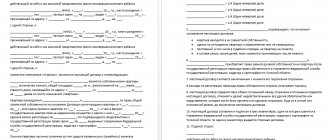When can an agreement be concluded?
Each married couple decides for itself at what point in their family life or after its completion they will enter into a voluntary agreement. It is not allowed to conclude such an agreement only before marriage, but this is understandable: until people have entered into a marriage union, they have no joint property and nothing to share.
A voluntary agreement should not be confused with a settlement agreement concluded during a trial. If the first is drawn up voluntarily and at any time after marriage, then the second can only be concluded in court if a certain procedure is followed (the settlement agreement is drawn up in court and the parties only sign it).
A married couple can sign an agreement on the division of joint property at any time after marriage:
- During marriage. In this case, the spouses can only divide the property that they had at the time of drawing up the agreement. Property purchased after signing the document is no longer subject to this agreement and, in the event of a divorce, it will have to be divided either by drawing up a new document or in court.
- During a divorce. If the parties are able to communicate and negotiate normally, then this is the most optimal option for partition.
- After divorce. The condition for drawing up a document after the dissolution of the marriage again becomes normal relations between the parties, when they are able to come to a mutually beneficial solution.
The relationship between amicable and out-of-court dispute settlement agreements
The expression “ pre-trial settlement agreement ” is incorrect, since law and practice distinguish between the following types of agreements:
- A settlement agreement is a mechanism the functioning of which is possible exclusively within the framework of the judicial process, that is, in this case we are not talking about pre-trial resolution of the situation, but about resolving the conflict at an early stage of proceedings in a judicial body (at the preparatory stage, before the court hearing).
IMPORTANT: no matter what stage of the process the settlement agreement is concluded, the procedure for its entry into force is the same - the text developed by the parties is submitted to the court for approval, after which a ruling is made by which the court either approves the agreement or rejects it and continues to consider the case in the general manner.
PLEASE NOTE: the specific approval procedure also determined a special procedure for canceling the document, namely, appealing the relevant determination, and not the agreement itself as a civil transaction (possibly within 15 days).
- Agreements concluded as a result of negotiations, without the participation of the court, are an option that allows the parties to reduce the material and time costs of finding a compromise.
Pre-trial settlement can be either voluntary, that is, carried out on the initiative of the disputing subjects (for example, a mediation procedure), or be mandatory provided by law or contract as a step, ignoring which closes the possibility of judicial protection for a person (claim procedure).
Differences from a prenuptial agreement
A marriage contract, unlike a voluntary separation agreement, can be concluded before marriage, but cannot be signed after its dissolution.
Other differences between an agreement and a prenuptial agreement arise from the legal nature and content of each of these documents:
- the marriage contract is valid for a certain time, the agreement is valid for an indefinite period;
- the agreement can only apply to the property specified in the document, while the contract implies any rights or their termination only after the occurrence of an event specified in the contract, for example, divorce;
- the contract stipulates the possibility of transferring personal property into joint property under certain conditions, but the agreement does not provide such an opportunity;
- the contract may have a generalized name of the property, for example, all real estate or all deposits, the agreement requires a listing of all items that are shared with their specific description;
- the agreement does not require a description of the debt obligations, unlike a marriage contract, where each debt obligation must be described.
Legal meaning
How to conclude a settlement agreement before trial? Only a documented decision can acquire legal force. If a “peace settlement” is formed at any stage of judicial proceedings, then its form is drawn up in accordance with the established rules. A sample agreement on pre-trial settlement of a dispute can be recorded in the following ways:
- draw up a document where the parties undertake to eliminate existing claims (pay debt, return property, provide services, compensate for losses, etc.);
- formulate an additional agreement to the existing one. The paper includes points to resolve the conflict;
- cancel the existing contract and sign a new one.
Is it necessary to notarize an agreement on the division of property between spouses?
Previously, when drawing up an agreement, it was not required to have it certified by a notary office. But due to recent changes in the RF IC, an agreement not certified by a notary will not have legal force. Why? The answer is obvious. When drawing up a document and signing it, the notary is obliged to explain to the parties each clause of the agreement, the consequences of its conclusion for each of the signatories, thanks to this, none of the parties will subsequently declare that he did not understand the essence of the agreement.
Moreover, the notary is a guarantor that the agreement was drawn up and signed by each of the parties voluntarily, that no pressure, threats or deception was exerted on any of the signatories, and that each spouse understood what document he was signing.
How to write a property division agreement correctly
The legislation does not determine the exact procedure for drawing up an agreement; the main requirement is that it must be in writing, written in legally competent language, must not contain legal or grammatical errors, and it must reflect the legal consequences of fulfilling or not fulfilling the conditions specified in the document. Of course, the document must be signed by both parties, and the spouses must also indicate in the agreement that they both agree to the terms of the division described in the document.
If the agreement is drawn up on several sheets, then the parties must sign each of them, then all sheets must be sewn together.
The agreement prohibits generalization of the name of property, such as houses or vehicles, and each item of property must be described as specifically and in detail as possible.
For example, a family has two dacha plots in joint ownership; in accordance with the agreements, both become the property of the spouse. In this case, the text of the contract cannot indicate this property as “all dacha plots” or “both dacha plots”. You will need to write: dacha plot No. 1 with a total area of ___ square meters, located at the address ___ and dacha plot No. 2 with a total area of ___ square meters, located at the address ___.
The text of the agreement itself must include:
- Preamble (header). The date and place where the document was drawn up, the personal data of the signatories and the details of the notary office in which the document was drawn up are indicated here.
- Subject of the agreement. In this paragraph, it is necessary to indicate whether the parties are married or divorced, refer to the document registering the marriage or its dissolution, and list all joint property that the parties intend to divide.
- Section order. Here it is necessary to indicate how the spouses want to divide the above property (what of the property goes to whom or the shares in accordance with which the property should be divided) and the procedure for the division (how, where exactly and in what time frame the division will take place), how it is planned to re-register etc.
- Personal property. The paragraph is completed if the spouses, in addition to common property, have personal property that is not subject to division (inherited, purchased before marriage, or received as a gift).
- Conclusion. This indicates how many copies of the agreement have been produced and where each of them will be stored. The procedure for making possible changes and resolving disputes between the parties, if any, is also determined.
- Signatures. Without the signatures of all parties to the agreement (including the notary), the document is considered legally void. It is advisable if, in addition to the personal signature, the parties write their last names and initials in their own hand.
What is the pre-trial dispute resolution procedure?
Pre-trial settlement is the procedure for presenting claims and the response to it. That is, the injured party can send the offender a letter of claim containing obligations that the offender has the right to fulfill or not fulfill. A claim is a statement presenting the following requirements:
- eliminating the circumstances that caused harm to the victim;
- payment of expenses and compensation;
- providing information, etc.
An attempt at pre-trial settlement occurs after the victim has learned of a violation of his rights
Laws and other legal acts that regulate the pre-trial resolution of disputes are determined by the type of dispute. For example, if the buyer’s rights have been violated, and a dispute has arisen between the buyer and the seller, then you need to refer to the Law of the Russian Federation of 02/07/1992 N 2300–1 “On the Protection of Consumer Rights”. And if copyright is violated, for example, in any part of it, the procedure for resolving the dispute is determined by Art. 7.12 of the Code of the Russian Federation on Administrative Offences.
Cases of mandatory and optional pre-trial dispute resolution
In some situations, if subsequent recourse to court is implied, pre-trial settlement (peaceful resolution of the dispute) is mandatory. This is stated in several legislative acts:
- Article 4 of the Arbitration Procedure Code of the Russian Federation;
- Article 132 of the Civil Procedure Code of the Russian Federation;
- Article 4 CAS RF.
Thus, the Arbitration Procedure Code of the Russian Federation requires a mandatory attempt to resolve a dispute peacefully in the sphere of public or economic legal relations. However, only if the law does not provide otherwise. It all depends on the type of legal relationship and the specific type of conflict.
Also, the Arbitration Procedure Code of the Russian Federation lists cases when a peaceful resolution of a dispute is optional:
- cases of establishing facts of legal significance;
- cases on awarding compensation for violation of the right to trial within a reasonable time or the right to execution of a judicial act within a reasonable time;
- insolvency (bankruptcy) cases;
- corporate dispute cases;
- cases to protect the rights and legitimate interests of a group of persons;
- cases of early termination of legal protection of a trademark due to its non-use;
- cases challenging arbitration decisions.
How much does an agreement on the division of marital property cost with a notary?
Signing an agreement at a notary office is not free. You will have to pay a notary for the services of checking and printing the document; this will cost no more than four to five thousand rubles. Also in notary offices there is a certain tariff established for certification of property documents.
When drawing up an agreement for an amount of less than one million rubles, the spouses will have to pay 0.5% of the agreement amount, the minimum payment amount will be three hundred rubles.
If the sum of the value of all divisible property is from one to ten million rubles, then the tariff will be 5 thousand rubles plus 0.3% of the value exceeding one million.
If the total value of the divisible property exceeds ten million, the tariff rate increases to 32 thousand rubles plus 0.15% of the value of the property exceeding ten million.
Agreement with compensation
In cases where it is impossible to divide joint property in kind (for example, a vehicle), spouses can enter into an agreement with compensation. The essence of such an agreement is as follows: one of the spouses receives the entire thing, and the other is paid monetary compensation in the amount of half the value of this property. Often, in exchange for indivisible property, the second spouse receives other material family assets that are equivalent in value to the property that cannot be divided.
For example, spouses have a vehicle, which, of course, is not actually shared. The couple agreed that upon division the car would go to the husband, and in return the wife would receive an expensive antique set, the cost of which would be equivalent to that of a car. Important. All conditions of the division with material compensation must be specified in the agreement.
Challenging and canceling an agreement
There are often cases when one of the parties to an agreement suddenly finds out that not all the property is indicated in the agreement or that she is not satisfied with some condition stated in the document. The legislation gives the right to any of the signatories to initiate changes to individual clauses of the agreement or its complete termination.
Of course, the other side should try to find a compromise again. If this happens, the parties can choose two ways to implement the agreements:
- Adjust a previously signed agreement, add additional clauses to it or correct existing ones.
- Terminate the concluded agreement and draw up a new contract.
If new agreements cannot be reached, the parties will have to decide in court whether the agreement should be declared invalid or, on the contrary, valid.
To invalidate the agreement, the plaintiff in court will need to prove one of the following grounds for making this decision:
- the agreement was drawn up contrary to the norms of current legislation;
- any of the parties to the agreement is declared incompetent;
- the interests of the plaintiff have been violated to a significant extent;
- the divisible property is not described specifically and vaguely, which allows the other party to take advantage of this fact in their own interests;
- there is no signature of any of the signatories of the agreement;
- the document was drawn up and signed after threats or pressure from one party towards the other.
Drawing up a voluntary agreement, like any other legal document, requires knowledge of legal terms, legislation, and certain rules when writing texts of this kind. It is unlikely that a citizen who does not have a legal education will be able to draw up a legally competent document, correctly apply all the legal terms in it and mention all the necessary legal acts without errors and inaccuracies.
But you can contact an experienced lawyer, he will help not only draw up the necessary document, but also tell you how best to divide the joint property, and warn you if your opponent in the division is trying to take advantage of your ignorance of the laws.
Save or share the link on social networks - lawyer FREE!
Write your question, our lawyer will prepare an answer for FREE and call you back in 5 minutes.
By submitting data you agree to the Consent to PD processing, PD Processing Policy and User Agreement
Why is such an agreement dangerous?
From the moment the parties sign the document, the decisions contained in it come into force. Consequently, all previous agreements between the parties are no longer valid. If, before the judicial settlement of the conflict, the sample is drawn up legally correctly and suits both parties, the issue is resolved. However, to change this decision you will need to negotiate again or go to court.
Additional Information! At the stage of preparing the agreement, all important points should be taken into account. If necessary, you should use the services of a lawyer or seek the help of a mediator.
If one of the parties refuses to comply with the terms of the agreement, its opponent will have to initiate an appeal to the court independently. In this case, there is no possibility of a simplified challenge of the case on appeal.
Notarization of a settlement agreement
Property and money disputes often end in a peaceful and mutually beneficial agreement. This type of document assumes that the parties have agreed on the terms of division and compensation when there are no claims or disputes. Most often, such an agreement is observed when resolving property disputes and calculating alimony. Property proceedings take place between former spouses, heirs or business partners. If it was possible to reach an agreement “peacefully”, a version of the contract is drawn up, or a court decision is made, which must be certified by a notary.
What exactly is being certified?
The notary office does not consider the correctness of document preparation, rational distribution of funds and other issues. This only implies verification of signatures and confirmation that an agreement has been reached between the two parties. That is, it is the signature of each of the parties to the transaction that is certified. In the event of a conflict arising in the future, the certified agreement of the parties can be considered as evidence in court. It is drawn up in triplicate, each party receives one original, including the notary. If the documentation complies with all the rules and procedures for drawing up, after certification its effect will be equivalent to a court decision.
Is it possible to terminate this agreement?
Unilaterally no! If there is a mutual will of the parties to terminate or revise the previously stated terms of the transaction, the notary can certify the new version, declaring the old version invalid. Also, violation of the proposed conditions by one of the participants is not a reason for terminating the contract, but is a reason for starting a lawsuit.
Certification by a notary when paying alimony
If the court has made an amicable decision regarding the procedure for calculating and paying alimony, the bailiff may require the agreement to be certified by a notary. In this case (the presence of a court decision), certification will not be mandatory, since it already has legal force. The specified conditions are binding. If an agreement is drawn up without the involvement of a court, it will become a mandatory condition for the legality of the concluded agreement. The amount, terms and conditions of payments, principles of transferring funds and the possibility of making changes to it are indicated here. The presence of a certified agreement allows you to avoid conflicts related to child support payments, makes it mandatory to fulfill all the conditions specified in the agreement, and also implies legal punishment for failure to comply with the payment procedure.
Agreement for division of property
Divorce proceedings are not always accompanied by insoluble disputes between spouses; there is often mutual understanding and a desire to resolve property issues for mutual benefit. This solution allows you to avoid lengthy legal proceedings that require significant expenditure of nerves and money. After drawing up an agreement, where you can use the help of a lawyer, the spouses have it certified by a notary, which gives it the status of a valid agreement and allows the property to be divided peacefully.
How to properly arrange the division of inheritance into shares?
Peaceful division of inheritance into shares by a notary is a safe and effective way of actually dividing property during the inheritance process. The essence of the agreement between the heirs is that ideal shares (parts) are transformed into real, physical objects, to which ownership rights are registered.
There are several ways to actually distribute shares of an inheritance “in kind”:
- Based on a verbal agreement. If the heirs have no conflicts and have reached an agreement, there is no purpose in dividing the property in writing.
- The method of selling and dividing the resulting amount of funds between the heirs. In this case, shared ownership rights are not converted into individual ownership rights to individual objects. Instead, the property is sold to third parties with the subsequent division of the received amount among the heirs in accordance with the ideal shares.
- Based on a notarized written agreement. In this case, the heirs clearly record their claims to certain real objects of inheritance. Moreover, if the distribution does not correspond to the ideal shares determined during the registration of the inheritance case, the agreement may provide for the payment of compensation in favor of those heirs whose rights were infringed.
- Based on a court decision. This is the most difficult method of division, since existing judicial practice in the Russian Federation shows that defending your rights to inheritance can be quite difficult. Problematic situations also arise related to heirs who have preferential rights during division.
Advantages of a notarial written agreement
The safest and most reliable method is to sign a written agreement with a notary certification. Here are its benefits:
- Prevention of possible legal disputes: the existence of an agreement ensures a clear record of the interests of each of the heirs, expressed by him personally and voluntarily, and in some cases, taking into account the interests of minor heirs.
- Checking for compliance with the legislation of the Russian Federation and available materials of the inheritance case. The notary checks whether the section reached in the agreement meets the existing requirements, and if it does not, he will not perform such actions.
- Simplifying the preparation of legal documents. If there is a documented division, together with a certificate of the right to inheritance, it is a reliable basis for formalizing and registering rights.
- Speeding up the procedure (compared to the court procedure).
- Accounting for the market value of objects. The notary takes into account the real value of the objects involved in the division in order to respect the interests of all parties.
Therefore, if there are several heirs, the best solution would be to sign an agreement on the division of property with a notary.
It is convenient to open an inheritance on weekends:
- The procedure takes 30-40 minutes
- No presence required. You can plan your time and walk around Moscow, sit in a cafe, go shopping
- Free parking
- Everything will be ready on the same day!
Agreement as a way of pre-trial conflict resolution
If the parties consider going to court as an unacceptable option for resolving the dispute, agreements can be reached through a negotiation process - either one-on-one or with the participation of a mediator.
The first step towards finding a compromise is filing a claim with the entity that failed to properly fulfill the obligation and caused the damage.
Next, a discussion of the situation begins, as a result of which the parties sign an agreement to satisfy the demands of the person whose interests were infringed, while the consultants involved can help find a mutually beneficial solution.
A sample pre-trial agreement can be downloaded from this link.
Such a document does not have the force of a court decision, like a settlement agreement, so its execution occurs voluntarily. If it is not fulfilled, the injured party will be forced to resort to judicial protection.
There is a special procedure for pre-trial conflict resolution - mediation, the detailed regulation of which is contained in the law “On an alternative dispute resolution procedure with the participation of a mediator (mediation procedure)” dated July 27, 2010 No. 193-FZ. This tool can be used both before going to court and after the trial has begun.
The essence of the procedure is to develop agreements with the participation of a specialist – a mediator, who assists in finding a beneficial solution, enshrined in the mediation agreement. The law notes the civil nature of such a transaction, indicating that the protection of rights in the event of non-fulfillment is carried out by methods provided for by the Civil Code of the Russian Federation.
Searching for agreements and consolidating them in the form of a settlement agreement within the framework of a judicial procedure is not the only possible option for resolving the dispute; if the parties decide to find a compromise, the agreement can be signed outside of court proceedings. There are various options for out-of-court settlement of disputes, including the mediation procedure, which is covered by a special law.
Settlement agreement on division of inheritance
Quite often, the inherited property includes several different real estate objects, which the heirs receive in shares determined by law. If they are not satisfied with the common shared property, they can draw up an agreement on the division of the inheritance at their own discretion.
In ordinary everyday practice, the term “settlement agreement” is often used not entirely correctly. It is understood as any agreement between the parties, concluded by mutual consent or, as they say, when the parties agreed to “amicable settlement”. However, from a legal point of view, two concepts should be distinguished:
- agreement on the division of inherited property - drawn up and certified by a notary in the absence of a dispute between the heirs;
- settlement agreement on the division of inheritance - is concluded as part of legal proceedings when the parties come to an agreement by consent.
In the second case, the court issues a ruling that has the force of a court decision. It immediately comes into force, and if one of the parties does not comply with it, you can obtain a writ of execution from the court and contact the bailiff for enforcement. However, in practice, most often, the division of inheritance means the conclusion of a peaceful, voluntary agreement with a notary on the distribution of objects of inherited property between the heirs.
When does the need for division of inheritance arise?
Typically, the division of property by inheritance occurs by will or by agreement between the heirs, however, there are other situations when a deceased relative did not leave a will. Then inheritance occurs by force of law. The property is divided equally among the heirs, named in turn. In practice, this often creates certain inconveniences for them. A good example is the division of inheritance after the death of a wife or husband.
Example 1. After the death of a spouse, an apartment, a garage, a plot of land and a car were left. He has two heirs of the 1st stage: a daughter and a son. According to the law, each of them will receive a certificate for ½ part of the entire property, and they will own it jointly. Thus, each property will have two owners.
A similar situation can arise in the presence of a will. For example, according to it, all property goes to the wife of the deceased. However, he is survived by his mother (a pensioner and disabled person), who has the right to an obligatory share of the inheritance. In order not to bring the matter to court, the wife and mother of the testator can go to a settlement and draw up an agreement with a notary on the division of the inheritance by mutual consent.
Protecting the interests of heirs during division
For some heirs, the law establishes special rules that must be taken into account when dividing the inheritance by agreement. When certifying it, the notary will definitely find out their presence and explain to the parties to the contract the rights and obligations of each of them. The special rules of inheritance legislation are as follows.
- If the testator has a conceived child who has not yet been born, the agreement can only be concluded after the child is born.
- If minor children or incapacitated relatives are involved in the division of property, the opinion of the guardianship authorities is taken into account when concluding the agreement.
- Heirs who live with the testator on the day of his death in the same residential premises and do not have other housing have a priority right to receive this residential premises and household items against their inheritance share.
- Legal successors who, together with the deceased citizen, owned an indivisible thing during his lifetime also have preferential rights to receive it.
- If an amicable agreement is not reached between the heirs having priority rights and other claimants, he must pay them monetary compensation for the lost share.
The debt obligations of the testator can be divided between the parties to the agreement only in equal shares. Sometimes it can be challenged as infringing on the rights of one of the heirs.
The procedure for dividing the common inheritance
In fact, it is possible to divide the common property left behind by a deceased family member only after receiving a certificate of inheritance. That is, when six months have passed after his death. The following must be taken into account.
- The heirs have the right to divide the inheritance at their discretion, deviating from the legally required equality of shares.
- An agreement on the division of inheritance (property) is an ordinary civil contract, certified by a notary for reliability.
- An heir who, according to an agreement, receives more than his allotted inheritance share in property, may pay others monetary compensation.
- Registration of real estate in the name of legal successors in the bodies of Rosreestr is carried out by a notary on the basis of a certificate of title and a concluded agreement.
- Registration of ownership of real estate cannot be refused if the certificate establishes equal shares, but the agreement establishes otherwise.
Example 2. So, in the above situation, the brother and sister agreed on the following. The apartment goes to the testator's daughter, the garage, car and summer cottage - to his son. Moreover, the cost of the apartment exceeds the cost of all other property, but this suited both parties.
How an agreement is drawn up (sample)
The legislation does not establish a strictly mandatory form for this document. In essence, this is an ordinary civil contract between two or more parties. It is usually drawn up when valuable property is divided: land, shares, cars, residential real estate, business. Such property requires registration of the right in state registers, so the agreement is always certified by a notary.
In general, the document includes the following provisions.
- Listing of all participants with their personal data (passport number, place of registration).
- Description of the inherited property subject to division, indicating the numbers of title documents (certificates of ownership, cadastral, registration numbers).
- The cost of real estate, things, securities (if necessary, with reference to an independent assessment report).
- The exact designation of the parts of the inheritance in kind, which, according to the agreement, each heir receives.
- Regulations on the payment of compensation, if provided for in the agreement, its amount, term and payment procedure.
- Additional agreements between the parties.
- Personal signatures of participants and their legal representatives (minors, incapacitated).
As a rule, the document includes a provision on the impossibility of non-fulfillment (refusal) unilaterally. Each agreement has its own characteristics. Therefore, a notary is involved in its development; its certification ensures recognition of the agreement by any government body.
Division of real estate
The transfer of the right to a land plot, a country house, an apartment to the heirs is registered in the unified state real estate register. Even if they have registered shared ownership of these objects, they have the right to then draw up an agreement on the division of the inheritance. But in this case, you will have to re-apply to the Rosreestr authorities and submit:
- personal documents (passports of each property owner);
- certificates of inheritance rights issued by a notary;
- notarized agreement on the division of inheritance.
Moscow notary Leksakova E.O. comments:
“Heirs can save time on registration if the documents and application to Rosreestr are submitted by the notary himself. Notary offices interact with government agencies using an electronic document management system, which speeds up the procedure for verifying documents and issuing a ready-made extract from the Unified State Register.”
Qualified notary Leksakova E.O. has extensive experience in registration of inheritance rights and will provide assistance in resolving complex issues.
Rules for drawing up and filing a claim
The claim letter must contain the following information:
- names of the parties;
- quality of legal relations;
- description of the offense;
- the actual requirements;
- date and signature.
A letter of claim as an attempt to peacefully resolve a dispute must be drawn up in accordance with the rules, otherwise such an attempt will not be counted by the court
Russian legislation does not have clear requirements regarding the drafting of the text itself. The claim can be handwritten or typed. However, the basic rules must be followed. The complaint must not insult anyone; the author must not apply direct pressure, threat or blackmail in the letter. It is necessary that the letter reflect information about what right was violated and how to correct it. Any demand must be based on legislative acts (for example, an article of the code), otherwise the offender may ignore the demand.
The claim must be sent by mail or delivered in person. For personal delivery, you can ask the recipient to sign the copy. If the letter is sent by mail, then you need to save all postal receipts, send the letter itself in a registered envelope, and before sending, ask the post office employees to make an inventory of the attachments. This will confirm that the claim was submitted and record the date. However, such sending does not mean that the court is obliged to consider postal checks as evidence.
Within 30 days of receiving the letter, the offender must respond. This could be a simple phone call, after which the result will suit both parties. For example, in the matter of debt. If the debtor received a letter with debt demands and called back, the creditor may propose a revision of the terms of the loan agreement, and the conflict will be resolved. The response can also be sent in writing. Sometimes such correspondence leads to an absolute resolution of disagreements, and the parties sign an agreement for the pre-trial settlement of the dispute.
The claim must be written in the style of a business letter, and the text must contain references to legal acts
Consequences of failure to comply with pre-trial procedures
If the parties to the conflict did not comply with the obligatory attempt to reach an agreement peacefully, then legal consequences arise, which are established by the following regulations:
- Article 135 of the Code of Civil Procedure of the Russian Federation - return of the statement of claim to the applicant.
- Article 148 of the Arbitration Procedure Code of the Russian Federation - leaving the claim without consideration.
Compliance with pre-trial order can play a decisive role in the dispute. Sometimes this is the only way to achieve full agreement, and a settlement agreement may contain conditions that are more beneficial for both parties than a court decision.
For example, in cases where we are talking about copyright infringement, and the victim must urgently travel abroad. The trial will take place within two months, but the offender may be ordered to pay damages. In a pre-trial procedure, the dispute can be resolved in a week if the offender simply eliminates the offense.
Pre-trial deadlines
In 2021, Federal Law No. 47 was introduced, which introduced changes to the Arbitration Procedure Code of the Russian Federation. The innovation not only obliges the parties to a civil dispute to reach a pre-trial settlement, but also sets a deadline for this. Thus, a claim in civil court can be filed only 30 days after the person who violated someone’s rights received a letter of claim, if the subject of the dispute implies a mandatory attempt to resolve the dispute before trial.
Compliance with pre-trial deadlines is an important point in preparing to file a claim.
If we are talking about a tax dispute, then an additional period of 10 days may be added to the main period of order (30 days). For example, during an audit, the tax authority discovered some shortcomings and sent an audit report containing information about this. If the responsible person does not agree with the act, he has a month to object (claim). The tax office must conduct additional checks. And if you are not satisfied with this result, then the responsible person can file an objection again, but within 10 days.
A person in respect of whom a tax audit was carried out (his representative), in case of disagreement with the facts set out in the tax audit report, as well as with the conclusions and proposals of the inspectors, within one month from the date of receipt of the tax audit report, has the right to submit written objections to the relevant tax authority on the said act as a whole or on its individual provisions. In this case, the person in respect of whom the tax audit was carried out (his representative) has the right to attach to written objections or, within the agreed period, submit to the tax authority documents (certified copies thereof) confirming the validity of his objections.
Clause 6 of Article 100 of the Tax Code of the Russian Federation






